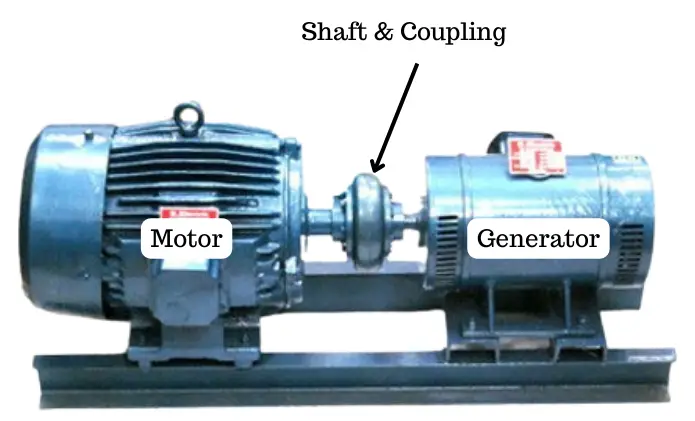A motor generator set consists of an electric motor and an electric generator connected by a common coupling. The electric motor converts electrical energy into mechanical energy, while the electric generator converts mechanical energy into electrical energy.
The motor generator sets are widely used in a variety of applications. However, their usage has diminished with the advancement in semiconductor and power electronic technologies.
Let us understand the basics of the motor generator set, construction, working, and applications.
What is a Motor-Generator Set?
A motor-generator set, also known as an M-G set, is an arrangement in which an electric motor and generator are coupled on a common shaft.
The M-G set mainly converts electrical energy from one form to another, such as AC to DC, single-phase to three-phase, or three-phase to single-phase.
The schematic diagram of a M-G set is shown in the following figure.

Let us now discuss the major components of a M-G set and their functions.
Components of Motor-Generator (M-G)Set
The main components of a M-G set are explained in detail below:
- Electric Motor – It is one of the main components of an M-G set. It converts electrical energy into mechanical energy, which is used to operate the coupled electric generator.
- Electric Generator – In the M-G set, an electric generator converts mechanical energy into electrical energy. Depending on its purpose, the generator can be a DC generator, a single-phase AC generator, or a three-phase AC generator. It is driven by an electric motor coupled to it through a shaft.
- Shaft and Coupling – The electric motor and generator are connected to a common shaft with a mechanical coupling in an M-G set. This shaft and coupling transfer mechanical energy from the motor to the generator.
After getting an idea about constructing an M-G set, let us now understand how it works.
Working of Motor-Generator Set
The operation of a motor-generator set is simple. Here’s a detailed explanation of how it works.
- Firstly, the electric motor is started by supplying it with electricity from an external source.
- The electric motor converts the electrical energy input into mechanical energy output.
- The mechanical energy generated by the motor is transmitted to the electric generator through a mechanical shaft.
- The electric generator converts the mechanical energy into the electrical energy.
- A control mechanism is used at the generator’s output side to regulate the electrical output parameters, such as voltage, current, frequency, etc., as per the requirements.
Advantages of M-G set
In certain applications, M-G sets have some specific advantages. Some of the common advantages of the M-G set are listed below:
- The primary advantage of the M-G set is that it provides an electrical isolation between input and output.
- It helps in matching the frequency between different systems.
- It allows phase conversion, i.e., three-phase to single-phase and vice-versa.
- It can provide a consistent and controlled electrical output to meet specific requirements.
- The output of a M-G set can be adjusted to perform load testing of various electric equipment.
Disadvantages
The following are some key disadvantages of the M-G set:
- A M-G set involves electrical to mechanical energy conversion, then mechanical to electrical energy conversion. At each energy conversion stage, some amount of energy is lost. Hence, an M-G set has a low efficiency.
- An M-G set is heavy because it has an electric motor, an electric generator, and mechanical coupling in a single arrangement.
- There is wear and tear in the moving parts of the M-G set. Thus, it requires regular maintenance.
- The initial cost of the M-G set is too high, which makes it suitable for some specific applications.
- Rotating mechanical components produces high noise and vibrations during the operation of the M-G set.
- M-G sets are not suitable for use in modern applications.
These are the key limitations of M-G sets that restrict their use in modern systems.
Applications of Motor-Generator Set
These days, M-G sets are less commonly used. However, they are still used in certain applications. Some of the key applications of the M-G sets are listed below:
- M-G sets are used for voltage conversion, i.e., high voltage to low voltage, low to high voltage, AC to DC voltage, and vice-versa.
- M-G sets are also used for frequency conversion to meet the requirements of specific systems.
- Motor-generator sets are used for phase conversion, such as single-phase to three-phase or three-phase to single-phase.
- They are used to provide electrical isolation between input and output.
- M-G sets are also used to smooth out the irregularities in the power supply and improve the power quality.
- They are also used to perform load tests of electrical equipment.
Conclusion
In conclusion, a motor-generator set is an assembly of an electric motor and a generator used for changing voltage and frequency and their conversion.
good